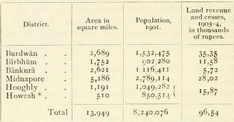Burdwan Division, 1908
This article has been extracted from THE IMPERIAL GAZETTEER OF INDIA , 1908. OXFORD, AT THE CLARENDON PRESS. |
Note: National, provincial and district boundaries have changed considerably since 1908. Typically, old states, ‘divisions’ and districts have been broken into smaller units, and many tahsils upgraded to districts. Some units have since been renamed. Therefore, this article is being posted mainly for its historical value.
Burdwan Division
A Division or Commissionership in Bengal, lying between 21° 36' and 24° 35' N. and 86° z^' and 88° 30' E. The Division, which covers an area commonly known as West Bengal, includes all the Districts of Bengal proper west of the Bhaglrathi, the earliest known channel of the Ganges, and corresponds roughly to the ancient Rarh and Tamralipta. The Bhaglrathi, called in its lower reaches the Hooghly, separates it from the Presidency Division, and it extends along the right bank of this river to its mouth in the Bay of Bengal. It is bounded on the south and west by the sub-provinces of Orissa and Chota Nagpur, and on the north by the Santal Parganas and Murshidabad District.
Though outside the Gangetic delta, the eastern portion of the tract is low and of alluvial formation. Farther west, laterite begins to predomi- nate, and the surface rises and becomes more and more undulating and rocky until at last, in the west of Eirbhum, Burdwan, Bankura, and Midnapore, it embraces the eastern fringe of the Chota Nagpur plateau.
Since the Division was constituted in 1854, the head-quarters have been several times moved between Burdwan, Howrah, Hooghly, and Chinsura. They were finally transferred to Chinsura in 1896. The table on next page gives details of the area, population, and land revenue of the six Districts of which the Division is composed.
The recorded population fell from 7,604,661 in 1872 to 7,393,954 in 1881, but rose again to 7,689,189 in 1891. The greater portion of the Division suffered severely from the ravages of the notorious Burdwan fever {see Burdwan District), which broke out nearly half a century ago and caused a terrible mortality. During the last twenty years the disease has gradually died out, and the population is at present rapidly increasing. There are now 591 inhabitants to the square mile. In 1 90 1 Hindus constituted 83 per cent, of the population, Musalmans 13 per cent., and Animists 3-|per cent., while there were 9,463 Chris- tians, of whom half were natives. The Division is peopled largely by castes closely allied to the tribes of Chota Nagpur, such as the Bagdi, Bauri, Kaibartta, Kora, Mai, and Santal. It is also the home of several distinctive castes with claims to a higher rank in the Hindu social system, such as the Aguri, Sukli, Sadgop, Kayasth, and Raju, and is the head-quarters of a well-known sub-caste of Brahmans.
The Division contains 27 towns and 24,869 villages, the largest towns being Howrah, the great suburb of Calcutta (population,
157,594), SeRAMPORE (44,451), BURDWAN (35,022), MiDNAPORE
(33,140), Hooghly with Chinsura (29,383), and Bankura (20,737). The Bh.\girathi, the old channel of the Ganges, is still the sacred stream of the Hindus, Triheni and Tarakeswar in Hooghly District possess considerable religious importance, and in Blrbhum several localities are associated with the legends of Hindu mythology. The whole of the strip extending along the west bank of the Hooghly from north of Hooghly town to the south of Howrah is of great historic interest, containing the sites of the old capital of Satgaon and of successive settlements of the Portuguese, English, Dutch, French, and Danes at Bandel, Hooghly, Chinsura, Chandernagore, and Serampore. The same tract, which includes Howrah, Bally, and Serampore, is now one of the most densely populated industrial areas in India. The north-west of the Division is rich in iron and coal, the centres of the industry being at Raniganj and Asansol ; the output of coal in 1903-4 amounted to 2,837,071 tons. Silk is manufactured in Midna- pore, Blrbhum, and Bankura.
The greater part of the estates of the Maharaja of Burdwan {see Burdwan Raj) lies within the Division. These were closely assessed at the time of the Permanent Settlement, and the present land revenue of the Division thus exceeds that of the great Patna Division, which has nearly double its area and population.
